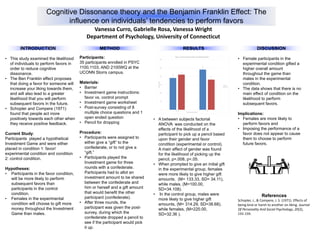
Research on Cognitive Dissonance and the Benjamin Franklin Effect
- 1. Cognitive Dissonance theory and the Benjamin Franklin Effect: The influence on individuals’ tendencies to perform favors Vanessa Curro, Gabrielle Rosa, Vanessa Wright Department of Psychology, University of Connecticut • This study examined the likelihood of individuals to perform favors in order to reduce cognitive dissonance. • The Ben Franklin effect proposes that doing a favor for someone will increase your liking towards them, and will also lead to a greater likelihood that you will perform subsequent favors in the future. • Schopler and Compere (1971) found that people act more positively towards each other when they receive positive feedback. Current Study: Participants played a hypothetical Investment Game and were either placed in condition 1: favor/ experimental condition and condition 2: control condition. Hypotheses: • Participants in the favor condition, will be more likely to perform subsequent favors than participants in the control condition. • Females in the experimental condition will choose to gift more money throughout the Investment Game than males. Participants: 35 participants enrolled in PSYC 1100,1103, AND 2100WQ at the UCONN Storrs campus. Materials: • Barrier • Investment game instructions: favor vs. control prompt • Investment game worksheet • Post-survey consisting of 8 multiple choice questions and 1 open ended question • Pencil for dropping Procedure: • Participants were assigned to either give a “gift” to the confederate, or to not give a “gift.” • Participants played the Investment game for three rounds with a confederate. Participants had to allot an investment amount to be shared between the confederate and him or herself and a gift amount that would benefit the other participant (confederate). • After three rounds, the participant was given the post- survey, during which the confederate dropped a pencil to see if the participant would pick it up. • Female participants in the experimental condition gifted a higher overall amount throughout the game than males in the experimental condition. • The data shows that there is no main effect of condition on the likelihood to perform subsequent favors. Implications: • Females are more likely to perform favors and • Imposing the performance of a favor does not appear to cause them to choose to perform future favors. References Schopler, J., & Compere, J. S. (1971). Effects of being kind or harsh to another on liking. Journal Of Personality And Social Psychology, 20(2), 155-159. RESULTS • A between subjects factorial ANOVA was conducted on the effects of the likelihood of a participant to pick up a pencil based upon their gender and favor condition (experimental or control). A main effect of gender was found for the likelihood of picking up the pencil, p=.008, p<.05. • When prompted to give an initial gift in the experimental group, females were more likely to give higher gift amounts. (M= 133.33, SD= 34.11), while males, (M=100.00, SD=34.108). • In the control group, males were more likely to give higher gift amounts, (M= 314.29, SD=38.68), while females, (M=220.00, SD=32.36 ). 0 500 1000 1500 2000 2500 3000 female male AmountinDollars Quasi Independent Varaible Figure 1: The Amount Chosen to Gift on the Differing Conditions Control Experiment DISCUSSIONMETHODINTRODUCTION
Notas do Editor
- Intro section: Try to streamline text even more.